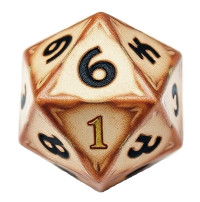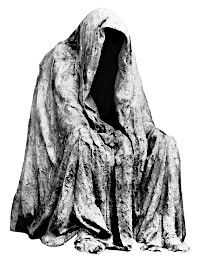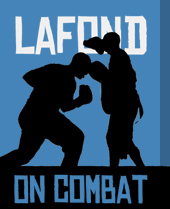My colleague, who writes as Teutonic Fist, operates an underground fight venue in Europe. Our exchange on edged weapon use in tight spots, particularly in the home, strikes to the core of the postmodern man’s predicament from the vantage of one of his most ancient tools.
Teutonic Fist
Since I take up boxing more regularly now it’s not untypical that i have brownish-red blood run from my head down when I take a shower afterwards in addition to the regular bruises so I had this urge to do some sword fighting again since the last time I did it was like 8 years ago.
I read that post about how useful a gladius is for home defence and since it is more complicated to legally obtain a gun in Germany and even more complicated to use that gun in a case of home defense many people discus this topic to use swords without knowing much about the use of one. Personally I would not use a gun myself if there is a noise in the night and one is still drowsy and now confronted with the possible scenario of multiple intruders and numbing oneself even more with a loud bang and a flash. Its not the ideal case but still the best one since if one is really willing to take a life in a case of self-defense, one better uses a fucking gun. So far the Gladius is one of the few sword types even considered useful since there is no swinging around in that type of environment. Traditionally home defense weaponry before the age of gunpowder was made up by long knives, often double edged. German word for "home defense"(Hauswehr) is still synonym for that type of knife. But a knife has to have a certain length or there is a danger that in a struggle it could be levered against oneself. The second problem is where to place a stab. The only place where you really guarantee a quick and silent kill is the kidney(s). A stab in the kidney leads to a shock where the victim is not able to utter any noises or struggle anymore. A stab in the spine and then rotating the knife to cut the spinal cord is way too risky and the lungs to collapse the lungs also. Second best thing is the lower body area. Cops always aimed for center mass but since body armor is widely used they aim for the lower body/pelvis area. If a good hit is placed there that cuts nerves and shatters bone the victim will collapse like a wet sack. At last there is the problem with the consequences of such sort of self-defense. When one uses a gun it’s a good advice to unload a whole magazine into the opponent so that one can say "I was afraid of my life". With the cold blooded and well placed stab to the kidneys with a double edge knife meant for killing people and not cutting bread that should be a different task.
Here are a few types of knifes meant for killing people that look cool:
The Swiss Dagger "Baselard":
link › kotte-zeller.de
$WS/kotte-zeller-shop/websale8_shop-kotte-zeller-shop/produkte/medien/bilder/gross/29029b.jpgNazi Daggers were modeled after this one.
Rondel Dagger:
This one being a cold steel reproduction.
The Misericorde "Mercygiver":
That’s usually a triangular nail rather than a blade so that it can go into the ribcage and pierce the heart from under the left arm. But that’s not a good move since a human can live up to 10 minutes with his heart
stopped beating.
All of these blades are thin, long and double edged so that they can go deep into the body and cut vital organs.
Other than that I would use a Push Dagger.
Saw them also on US military personal in Iraq wearing them. They come in very handy in hand-to-hand combat situations.
James
I recommend the Lancaster County Military Edged Weapon Museum, for the illustration of parallel tracks in modern military edged weapon design.
The Welsh trench sword, basically an ancient leaf-shaped short sword, was a good hacking weapon for trench warfare, but so was the entrenching tool. Otherwise, blade evolution in European warfare over both World Wars followed the thrusting logic of the commando, who combined a mouth covering hold with a base of the brain stab, lung stab or throat slice, or was required in desperate melee to thrust through heavy clothing.
In the Pacific, from 1901 through 1945, heavy cleaving knives and machetes were favored due to:
-1. Light clothing
-2. Heavy cover
-3. Filipino, Gurkha and Japanese fanaticism, blade use, closing tactics and drug use.
The knife thrust, unless made to the brain, does not stop instantly, does not deliver shock, but rather initiates a bleed. With light clothing a broader cutting blade also makes a larger, quicker flowing, blood channel. However, the main use of the heavy cutting blade in tropical firearms combat, as exemplified by the Gurkhas in Burma, particularly at the Battle of the Admin Box, an overrun situation, was for decapitation and head cleaving.
The only Pacific War vet who spoke to me about hand-to-hand combat was a Navaho cook on Guadalcanal, who showed me the picture of the Jap who he had head cleaved to the jaw with his meat cleaver when the kitchen was overrun. The second hand accounts I have gathered mostly sketch a picture of Americans using firearms to block blade strokes and then returning fire at pointblank range.
Teutonic Fist
Check out also the V-42 Combat knife and the modern V-10 Combat Knife. Other WW2 Combat knifes that resemble the classical Dagger are the SAS knife and the M3 Combat knife. After the War my Gramps used his SA to slaughter pigs. A knife that gained some renown is the American Trench Knife with the Knuckle Duster Grip, but these were never used since they just got to Europe when the War was already over. German soldiers used mostly double edged Hunting Knifes, Deer Catchers (Hirschfänger)
until combat knifes got introduced since the bayonets at that time were usually too long to be useful in hand to hand combat. Modern Bayonets are often machete formed like the mid cold war AKM bayonet and the Army M9 Bayonet is modelled after that. The Idea was basically that when you ram it into someone you ram it upwards and so the blade form is meant to hook into some fabric or gear of the enemy and penetrate from there. That was the idea but outside from war crimes there is actually no real documentation that bayonets were ever used and that’s why many modern armies just abandoned them.
James
In the American Civil War, it was noted by numerous observers that bayonet charges were never driven home, but usually resulted in either the defenders breaking and running or the attackers breaking and going for cover.
At this time there was a minor battle between a platoon of the French Foreign Legion guarding a payroll shipment and a regiment of irregular Mexican cavalry, in which the legion’s reputation was made when the three last men made a pact and did a suicidal bayonet charge.
Successful uses of the bayonet have been three that I know of:
French column attacks in the Napoleonic Era, in which the men in the front ranks were literally shoved forward by the press of hundreds behind them. The use of this tactic was to break firing lines and then fire into parallel ranks, not to slaughter with the bayonet.
The use of bayonets against enemies armed with shield-hand weapon combinations, most notably the English plug bayonet versus the Scottish targe and claymore, at either Culloden or Monmouth, and the sever casualties inflicted upon Zulu warriors armed with hide shield and asagi by British infantry at Indiswana and Rourke’s Drift. The Zulu king described these two battles as a spear being thrust into the nation’s belly and then twisted.
Lewis Millet’s charge up a Chinese-held hill in Korea in which the GI’s primarily stabbed the Chi-coms in the head as they towered over their foxholes.
Being a Bad Man in a Worse World
Fighting Smart: Boxing, Agonistics & Survival











en.wikipedia.org/wiki/Battle_of_Camar%C3%B3n
Thanks, Shep
“Very few people have ever been killed with the bayonet or saber, but the fear of having their guts explored with cold steel in the hands of battle-maddened men has won many a fight.”
-General George S. Patton Jr., 1885-1945
“In a man-to-man fight, the winner is he who has one more round in his magazine.”
- Oberstleutnant Erwin Rommel, Infanterie greift an (Infantry Attacks), 1930
"We had acquired some Chinese documents stating that Americans were afraid of hand-to-hand fighting and cold steel...when I read that, I thought, 'I'll show you, you sons of bitches!'"
Captain Lewis Millet, MOH, U.S. Army badassoftheweek.com/millett.html
During the past 160 years, as firearms became longer ranged and faster loading, the bayonet has come to be regarded by the world’s militaries as largely a terror weapon. And pretty effective one too actually, which is why it is still extant. In the experience of the American and British militaries whether or not bayonets will be used in war is largely a self-fulfilling prophecy: Soldiers trained to use the bayonet use it in battle; soldiers not trained to use the bayonet don’t use it. In fact if your preconceived notion is that a bayonet is not a useful weapon on the modern battlefield you will probably not even bother to carry one, or issue the ones that are part of your unit property to the soldiers under your command. Prior to the Korean War U.S. Army soldiers were not trained in the use of the bayonet and promptly discarded the rifle bayonets they were issued whenever they sought to lighten their load for a long foot march at the Korean Conflict’s beginning. Army Historian S.L.A. Marshall found that a notable exception to that trend was the M4 carbine bayonet. The M4 carbine bayonet had a 6-3/4 inch spear-pointed blade with a sharpened false edge half-way up the spine, like the WWII issue M3 ‘Trench Knife’. All in all the M4 made for a handy camp knife compared to the big, unwieldy, and usually issued dull, M1 Rifle bayonet, so soldiers generally hung on to them. Consequently several future versions of the infantry rifle bayonet (M5 thru M7) were given the same blade shape as the M4. Anyway, after the initial engagements of the Korean War the leadership of the U.S. Army became quickly disabused of the notion that hand to hand fighting had become unlikely in modern warfare. So the Army quickly reinstituted training in bayonet fighting and the results were spectacular. One well known case of course was Lew Millet’s charge at Hill 180 in 1951. Another was the POW Camp riot on Koje-do Island off the southern coast of Korea. In May-June 1952 some 50.000 Communist POWs had taken over the camp complex and even held the American camp commandant hostage at one point. After “comic opera negotiations” with the Communist POWs failed to restore American control of the camp, U.S. combat troops were sent in. The Paratroopers of the 187th Airborne Regimental Combat Team supported by half a dozen Patton Tanks took back control of compound 76 without firing a shot. The Paratroopers used bayonets, tear gas, concussion grenades and “fists” to drive the POW’s out of their defensive positions. In the two and a half hour battle 31 POW’s were killed and one paratrooper was speared to death. The British Army trains its soldiers extensively in bayonet fighting and as a result British troops have used the bayonet in nearly every conflict they have been involved in, including the Falkland Islands War and the current Global War on Terror: telegraph.co.uk/news/worldnews/asia/afghanistan/9571522/Soldier-who-led-Afghanistan-bayonet-charge-into-hail-of-bullets-honoured.html.
Nowadays bayonet fighting tends to occur largely between small groups of soldiers. There is lot more of this going on than the public is made aware of. Large ‘classic’ bayonet charges ala Pickett’s Charge and Cold Harbor don’t seem to occur anymore, given modern firepower and the frequent compartmentalization of the battlefield in modern conflict. However, at Pelleliu the U.S. Marines executed what WOULD have been characterized as a mass bayonet charge in taking the airfield, had anyone bothered to give the command of ‘fix bayonets’ that is. I guess such a formality must not have seemed important at the time, eh? In any event hundreds of Marines rose as one and charged upright over flat, open ground amid shot and shell, for several hundred yards. In the U.S. Army’s current experience the bayonet has been used more often in the dismounted role, like a regular knife or dagger. According to the research done by Matt Larsen, former Ranger sergeant and current civilian director of the U.S. Army Combatives training program, the most common hand to hand scenario in the current GWOT is for an enemy combatant to jump out of hiding, grab the soldier’s rifle and attempt to pull it away from him. Matt Larson’s prescribed ‘school solation’ for dealing with such an attack is to draw a bayonet or knife from one’s belt and stab the assailant to death. Matt Larsen even corroborated with Gerber Cutlery Company in designing a knife sheath combination optimized for such a purpose: the Gerber LHR Combat Knife knifecenter.com/item/GB0183/Gerber-LHR-Combat-Knife-687-inch-Fixed-Blade-Reeve-and-Harsey-Design-30-000183; gerbergear.com/Activity/DEFEND/LHR-Knife_30-000183
Unfortunately for some bizarre reason Gerber quickly stopped manufacturing the LHR. WWII era Commando type troops favored stabbing weapons because they were told that they would be expected to stab enemy soldiers and kill silently in the normal course of their operations. In fact in selection interviews candidates for service in commando type units were regularly asked if they thought they personally had what it took to kill an enemy soldier with a knife? Whether they actually did stab enemies or not depended on the circumstances they eventually came to find themselves in. As Steven Dick, SF Vietnam Vet and former editor of the now defunct ‘Tactical Knives’ magazine, opined that between engagements infantry combat is one long camping trip. So the modern American infantryman has tended to eschew dagger style blades in favor of hunting style knives that would be as useful for all sorts of prosaic camp and survival chores as it would be for stabbing an enemy. For the past 50 years the Ka-Bar, the Buck Model 119, the Buck 110 lock-blade folder, the Puma Bowie, the Puma White hunter and the Cold Steel SRK, Cold Steel Recon Tanto and, at the high end, the Randall NO 1 and the Reeves Yarborough Green Beret knife, have been favorites. Might not a solider carry a dagger type fighting knife like the Fairbairn-Sykes, the Applegate-Fairbairn, the Gerber MKII and the Randall No. 2 in addition to a camp knife? Maybe so, but keep in mind that the common light infantryman is always seeking to lighten the load on his back (and feet), thus some have even gone to the extreme of cutting the handle off their tooth brushes. So likewise the average infantryman is likely to decide that such a specialized weapon, one he has not been expressly ordered to carry by his superiors, might not be worth the extra weight, no matter how slight it may seem in isolation.
Jeremy, Thanks this wealth of information.
"...a bad example for society":
youtube.com/watch?v=Q1zH14cJ2AE
Good for hacking through pork ribs, too.
Why stab when you can chop?
youtube.com/watch?v=z9o5-WWo5JQ
Once again, cool videos Bob! Very illustrative. They bring up the point that the swinging, clubbing blow is more natural to human beings than the trusting, straight punching blow. Such that even when using a stabbing weapon an untrained person is likely to stab using a swinging blow. Whether such blow is delivered underhanded or overhanded. The Chinese cleaver is a common weapon in criminal assaults in the Orient because it is so ubiquitous. There’s one in every kitchen. This is due to the fact that the Chinese serve all food already chopped up, rather than serving it whole to be cut into bite-sized pieces by the individual diner, as in the fashion of European cultures. It also amply illustrates why the world’s major militaries transitioned to mostly thrusting swords for their horse cavalry in the late 19th Century. Following the Napoleonic Wars there is was much discussion in European military circles on whether the cut or the thrust was more effective for cavalry swords. They came to the conclusion that while both the cut and the trust with a heavy cavalry sword could put an enemy out of action, the trust was more likely to be fatal. The deeply curved British 1796 Light Saber (AKA the ‘Blucher Sabel’) was notorious for delivering hideous looking slashing wounds (Napoleon even protested its use). Nevertheless the greater likelihood that a stab would be fatal was noted by leaders like Captain Bragge of the 3rd British Dragoons at the battle of Bienvenida where British cutting swords met French thrusting swords. Captain Bragge wrote: “Scarcely one Frenchman died of his wounds although dreadfully chopped, whereas 12 English Dragoons were killed on the spot and others dangerously wounded by thrusts. If our men had used their swords so, three times the number of French would have been killed.” Likewise our unfortunate Taiwanese traffic cop was ‘horribly chopped’ yet still very much alive and kicking at the end of it. Had the cop been armed with a pistol, or even a knife himself, he might have mortally wounded his attacker in spite of his grievous wounds. Save for a chopping blow that completely severs a limb or splits the skull, cuts to the inside of the arms are more likely to be disabling and impede an opponents’ ability to fight back than cuts to the outside of the body which is more likely to be protected by bone and thick muscle. Inside the arms is where the major blood vessels and important tendons are. Also a deep slash to the abdomen, ‘dropping the guts’ Gaucho style, is a likely fight stopper. Same with a cut to the forehead that causes blood to run into the opponent’s eyes. Otherwise a trust with a blade is most likely to cause fatal bleeding. Bleeding that will be more immediately incapacitating as well. Finally the police officer’s ghastly injuries are a good argument for wearing some kind of body armor whenever one is engaged in any occupation that features the likelihood of having to interact with angry and violence prone members of the public. Especially given our brave, new multicultural society, one never knows when some individual might become unexpectedly provoked to extreme, life-changing violence over something that seems petty and inconsequential to the rest of us.
thanks for the information, Jeremy.
Burton advocated thrusting with the curved saber as it made a wider blood channel than a straight saber.
Interesting points, Jeremy, thanks.
Here's one of the best "knife defense" clips I've seen. Great presence of mind shown by the victim.
youtube.com/watch?v=8wg4nFUp1hE
I like the guardless Ek #1 and 2 designed for ease and speed of extraction. Of course, the odds of ever having to use it violently are extremely low. But how many actuaries do you want at your wake?
fairbairnsykesfightingknives.com/ek-knives.html
Jeremy,
Perhaps the thrust is easier to pull off with the extra momentum of the horse and the confidence that comes with having your vital organs up high and inaccessibile to your horseless opponent.
My line of thinking is that the substance or adrenaline-affected aggressor may be better stopped by heavy chopping blades that break or shatter and well as cut, especially if heavy clothing is the order of the day. Stab victims often not realizing their wounds till after the attack. Immediate cognizance of the wound helping to demoralize the malefactor.
To Anonymous. Actually the momentum of the galloping 1100 pound cavalry horse during a charge served to increase the force of both the thrust AND the cut. For example, there are many accounts of musket barrels being cut clean in two by a cavalry sword. In their study of the issue military leaders came to the realization that the clear division of labor that existed between the different types of cavalry had much influence on the issue. Heavy Cavalry tended to more often charge as a unit, riding shoulder to shoulder, so the thrust served them better. Whereas light cavalry, like Hussars, tended to operate in small patrols, scouting for the enemy and attacking enemy scouts to prevent them from reporting back. Therefore light cavalry got into man to man fights with enemy light, unarmored cavalry more often, so the curved cutting sword served them better. The Hussar was very offensive oriented; he went in swinging. He didn’t worry so much about defense or footwork. The horse was trained to do the foot work (See Dressage youtube.com/watch?time_continue=203&v=cDKWnCNpmQA), and maneuver alongside the other horse so the Hussar could split the other guy’s skull. The Hussar typically wore that stupid looking ‘pelisse’ (fur lined jacket) hanging over his left shoulder to provide a modicum of protection against enemy sword cuts. Anyway all cavalry swords whether made for cutting or thrusting were long and heavy being optimized for fighting on horseback rather than being light and maneuverable for fighting on foot. Anyway, the cut vs. thrust cavalry sword controversy was the Ford vs. Chevy, revolver vs. automatic and 9mm vs 45 argument of its age, both sides had their good points and their blind spots.
It's hard to predict how human beings will react to wounds since there are so many variable factors that will impact on both the severity of the wound as well as how the wounded man will respond. Yeah, a powerful cut that breaks bones and /or severs limbs will tend to end a fight decisively. One that chops off a head sure will. But those can be difficult blows to deliver, especially with a heavy sword that makes your arm tired from swinging it in short order. It's much easier, and doesn't require the use of a heavy, unwieldly chopping blade, to inflict a fatal wound on your opponent by giving point, by thrusting. Just sticking six inches of a light sword blade inside your opponent's torso can put your opponent out of action for good and all. But again, different cavalry types were best served by different types of swords tactically speaking.
To Bob. Yeah the defender did a good job of avoiding the knife. What saved him was appropriate ‘situational awareness’. Clearly he understood that he was in prison and that ‘shankings’ happened there, regularly even. He didn’t waste precious seconds in a mental freeze telling himself ‘this can’t be happening’. Rather he accepted the fact that it was happening and that he had to move NOW, thereby avoiding receiving a mortal wound in the initial assault. One notices that white people tend to react to ‘surprises’ like they believe they are being pranked by someone who is actually harmless, whereas black people tend to react to the same sort of surprises like they believe they are under actual attack, and respond accordingly (Scarecrow on the porch youtube.com/watch?time_continue=4&v=i3agHc02aPo) Nevertheless, I’m sure white folks will learn how to respond more appropriately to ambushes as the places where they live become less safe. Although some are naturally going to have to learn the hard way before they internalize the proper response, unfortunately.
@ Jeremy:
Thanks, "Anonymous" with a name foul.
There is something quite intimidating about mounted police (I've witnessed effective crowd control with mounted police using batons; even as a bystander you don't want to get too near in case you get trampled or kicked in the confusion).
But's it's even more elemental. The sharp sound of hooves moving rapidly on concrete itself is frightening. You really sense the weight of the beast. It's a bit like heavy leather-soled shoes; one is able to communicate authority or menace through the sound of one's gait. The Royal Guard has pretty well been emasculated, but can at least still stomp.
youtube.com/watch?v=TmCnYXOO33I
I like my leather-soled shoes fitted with steel smile-shape taps to protect the toes, where most of the wear occurs. This also makes them slightly noisier, but not disagreeably so. Metal heel caps are so loud as to attract attention and make for a slippery shoe. I like leather heels with a rubber edge. A nice balance between sound and safety.